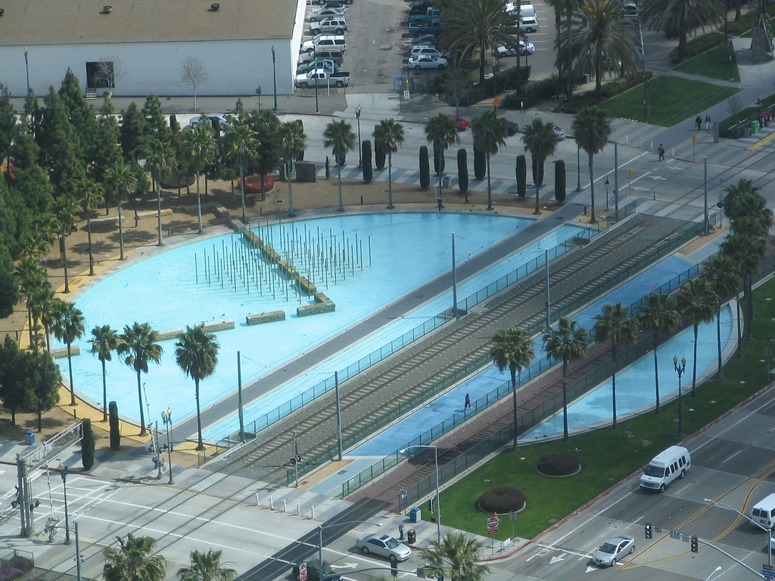Sometimes, I wonder if landscape architects have borrowed my diagram of the postmodern style and scanned it into their computers. But since this design for a reflecting pool and fountains at Children’s Park and Pond in San Diego, California (by Peter Walker) won an an ALSA award in 1998 it would be better to ask me if I used it when drawing my style diagram – in 1999. The answer would be ‘No’ and I would classify the design as ‘geometrical postmodernism’ rather than ‘ecological postmodernism’ or ‘functional postmodernism’. The Peter Walker website puts it like this: ‘ An outdoor space for the Children’s Museum, this project transforms the traditional elements of a park — turf, flowers, benches, shade, and water — into whimsical abstractions. The vast horizontal expanse of a two hundred-foot wide pond is reinforced by a circle of tall Mexican fan palms. A fountain animates the pool with a grid of Rainbird sprinkler heads. The monumental pond also articulates the intersection of the park and the linear Martin Luther King Jr. Promenade, as it is literally traversed by the tracks of both light rail system and train.’ – and the key word is ‘whimsical’.
Picadilly Gardens in Manchester, by EDAW, also resembles my diagram but the design was done in 1998.


I don’t get it?! Is this playscape ment to be build as fun for childeren?
It looks dangerous to me…
Picadilly Gardens is looking somewhat sorry for itself these days. The benches seem to be rapidly rotting away and the expanses of grass have been reduced to dust by a multitude of desire lines. Some of this could be the product of low (or no) maintenance but I suspect the original design may also be at fault – should it all have been paved?
Melanie: yes- I think it WAS meant to be fun for children.
Adrian: I am sorry to hear about Picadilly Gardens rotting away (do you have a recent photo?) and I suspect the general problem (pace EDAW) is that they did not have an ecological strategy for the space. It was a visual and social design without the support of a vision as to how the materials would weather or how the space would change in time or how the space would function in varied climatic conditions. It was, in other words, a Martini approach to urban design.
As Tom has identified, the space is whimsical. As Adrian has reported, it’s impractical.
What one surely must ask is how such nonsense comes to be designed by trained professionals, and how are those who commission these projects so hoodwinked at the presentation stage.
Is this a case of ‘bullsh*t baffles brains’ How much more of this carry-on happens in our urban neighbourhood ?
Adam, I think part of the problem does indeed lie with the design philosophy used by the design team but for public landscape architecture projects one can never discount the significance of clients, planners, health and safety folk etc in mucking up projects. They all think they know best and they rarely do know best.
It is VERY difficult to know who knows best, because there is no consistent answer. one would expect landscape architects to be best at landscape architecture, architects to be best at architecture etc etc. But it is not always the case. My own view is the best hope of improving the built environment is to have better clients. We had an interesting discussion of Castleford on this blog and my conclusion was that the clients were much more sensible than the designers – but only when they were ‘real people’ (rather than government officials).
i just want to ask what was the estimated bugdet and who was client of this project
Hi Tom,
Big fan of your work and book Garden History! To an inspiring Landscape Design student at Montana State University, any suggestions for me to follow to become a successful designer? I’m under the instruction of Yousef Zadegan, a brilliant professor and M.L.A, and currently gaining hands-on experience as a landscaper for Alpine Building Company. I’m just a 20 year old kid with a dream of producing creative solutions in a modern world. It would mean a lot to me to hear some advice from someone of your expertise. My e-mail is hans.turner@msu.montana.edu. Thanks!